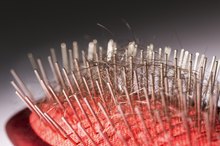What does fact checked mean?
At Healthfully, we strive to deliver objective content that is accurate and up-to-date. Our team periodically reviews articles in order to ensure content quality. The sources cited below consist of evidence from peer-reviewed journals, prominent medical organizations, academic associations, and government data.
The information contained on this site is for informational purposes only, and should not be used as a substitute for the advice of a professional health care provider. Please check with the appropriate physician regarding health questions and concerns. Although we strive to deliver accurate and up-to-date information, no guarantee to that effect is made.
Propecia vs. Rogaine
Minoxidil is a medication that’s commonly marketed under the name Rogaine, and finasteride is marketed under the label Propecia. You might use either Rogaine or Propecia to help treat hair loss. Talk with your physician before you use these medications for hair loss, because they both pose certain health risks, drug interactions and side effects.
Function
Rogaine and Propecia both inhibit hair loss while promoting hair growth, explains the University of Pittsburgh Medical Center 23.
Rogaine is an over-the-counter treatment used primarily for treating androgenetic alopecia, also called male- and female-pattern baldness, and alopecia areata, an autoimmune disease. Rogaine appears to make hair shafts thicker and increase the number of hair follicles, notes the University of Michigan Health System.
Propecia requires a prescription. It is used to treat androgenetic alopecia specifically in men. It affects male hormones that cause hair loss by blocking testosterone’s conversion into dihydrotestosterone, or DHT.
- Rogaine and Propecia both inhibit hair loss while promoting hair growth, explains the University of Pittsburgh Medical Center 2.
- Rogaine is an over-the-counter treatment used primarily for treating androgenetic alopecia, also called male- and female-pattern baldness, and alopecia areata, an autoimmune disease.
Applications
How Long Does it Take for Rogaine to Work?
Learn More
Rogaine is a topical treatment that comes in the form of a foam, lotion or liquid spray. It is available in a 2 or 5 percent concentration solution that you apply to your scalp twice each day.
Propecia is a pill taken by mouth once daily or as directed by your doctor.
Timeframe
Rogaine topical solutions can take up to four months of daily use to show maximum effect, nnotes the University of Pittsburgh Medical Center 23. If you don’t see a significant change in hair loss or growth after six months of use, you might want to try a different remedy. Unlike Propecia, Rogaine might generate new hair growth that’s much thinner and shorter than your regular hair.
Noticeable results from taking Propecia can occur in as little as three months or up to one year.
- Rogaine topical solutions can take up to four months of daily use to show maximum effect, nnotes the University of Pittsburgh Medical Center 2.
Side Effects
How to Make Your Eyebrows Thicker
Learn More
Both Propecia and Rogaine can cause some side effects. Rogaine can cause itching, dandruff and skin irritation, cautions the University of Michigan Health System. Also, women who use Rogaine could grow unwanted facial hair. Propecia can cause erectile dysfunction, low sex drive and other sexual-function problems in men. Propecia might also cause drug interactions, so talk with your doctor about any other medications that you’re taking.
- Both Propecia and Rogaine can cause some side effects.
- Propecia can cause erectile dysfunction, low sex drive and other sexual-function problems in men.
Warnings
Propecia poses serious health risks to women and children. Pregnant or breastfeeding women shouldn’t take or even handle Propecia pills, and men taking Propecia should use birth control with their partners to prevent pregnancy while on the medication, warns the University of Pittsburgh Medical Center 23. Propecia could cause serious birth defects. Women using Rogaine who also take estrogen-containing medications like oral contraceptives or hormone replacement therapy could experience enhanced hair growth, notes the University of Michigan Health System. If you’re pregnant or breastfeeding, you should ask your doctor before using Rogaine.
- Propecia poses serious health risks to women and children.
- Pregnant or breastfeeding women shouldn’t take or even handle Propecia pills, and men taking Propecia should use birth control with their partners to prevent pregnancy while on the medication, warns the University of Pittsburgh Medical Center 2.
Related Articles
References
Writer Bio
Sarah Terry brings over 10 years of experience writing novels, business-to-business newsletters and a plethora of how-to articles. Terry has written articles and publications for a wide range of markets and subject matters, including Medicine & Health, Eli Financial, Dartnell Publications and Eli Journals.









